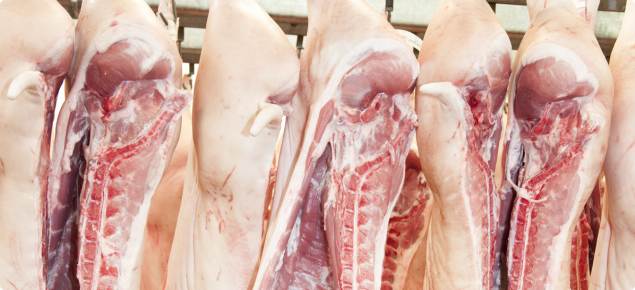Factors contributing to increased backfat (P2)
Genotype
The aim in pig breeding is to select later-maturing animals as these have a greater genetic capacity for rapid lean growth up to slaughter weight. Poorly selected stock tend to be slower growing and fatter at slaughter. When producers select their own replacement stock, they run the risk of reducing the genetic potential of their stock if they select for rapid growth but not rapid lean growth (which requires a measure of P2 to be taken into account in the selection process). Breeding companies can assist with providing animals or semen to reduce P2 and increase lean meat yield.
Sex
Since entire males are later maturing than females, they tend to be leaner at a given slaughter weight than females and are more efficient at converting feed to lean tissue. The differences between entire males and females are reducing as genetics continue to improve. Castrates will perform more like females, hence are likely to be fatter at slaughter than entire males. Immunocastrates are typically somewhere between a female and an entire male but this depends on when the second vaccination is given.
Distorted growth patterns
Pigs that have a growth check, for whatever reason, are known to be able to compensate when conditions improve. If feed intake is restricted during the grower phase (up to 50 kilograms liveweight) due to overstocking, poor health etc, then access to feed improves during the finisher phase, pigs will eat more nutrients than they are capable of utilising, with excess nutrients converted into fat.
Diet specifications
Highly selected genotypes have higher protein deposition rates than poorly selected genotypes and both must be fed diets that meet their requirements. If highly selected genotypes are fed a diet low in protein (amino acids), then their potential for deposition of lean muscle will not be met and they will convert excess energy into fat stores. Conversely, poorly selected pigs fed a high protein diet will not be capable of utilising much of that protein and will consequently also direct excess nutrients into fat stores.
Liveweight/age
As a pig grows towards its mature body size and weight it deposits relatively more fat and less muscle. Pigs held back for different reasons (e.g. illness or injury) are as a consequence more mature than their pen mates of the same bodyweight and more likely to have higher P2s.
Change in grading schedule
Grading schedules can change. If there is an increase in the proportion of pigs missing the top grade, check that there hasn’t been a change to the carcass weight and/or P2 requirements.
Excess intake
All pigs have a set genetic potential for growth. If for whatever reason pigs consume nutrients (energy and amino acids) in excess of what they can utilise, then the animal will convert these into stores of fat.
Irregular intake
As with a distortion of growth pattern, it is possible that even short-term disruptions to feed intake may affect carcass quality. For example, a pig that consumes 1 kilogram (kg) on one day and then 2kg the next, will end up being fatter than a pig that consistently consumes 1.5kg every day.
Pigs fed the wrong diet
If pigs are fed the wrong diet, then the nutrient supply does not match the pig's requirements and an increase in P2 could result. This may occur if the wrong diet is delivered to a pen of pigs but it may also happen if there is a large variation in liveweight within a pen of pigs. Hence it becomes impossible to meet the requirements of all animals.
Separation of the diet
If the diet is not mixed well enough or through delivery there is separation of nutrients (especially important micro-ingredients such as lysine), it will lead to irregular nutrient intake and hence a likelihood of greater variation in pig’s P2.
Poor feed ingredient quality
If the quality of ingredients (such as grains or protein meals) is not as good as was assumed when the diet was formulated, then the diet may supply inadequate nutrients. Therefore the requirements of pigs of high genetic potential are not met causing them to have higher P2s at slaughter.
Season
Pigs are very sensitive to changes in ambient temperature and this can be reflected in changes in feed intake. As mentioned previously, irregular intakes and a distortion to the pattern of growth will often lead to poorer carcass quality.

